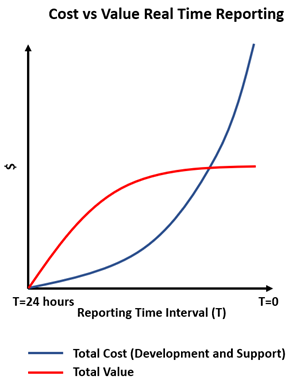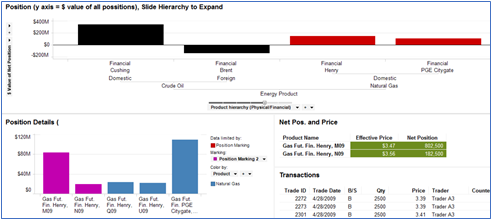Real-Time ETRM Capabilities: What’s The Value Add & Key Challenges?

In the modern trading world, there’s new data constantly available. Traditional energy trading and risk management (ETRM) systems take time—usually overnight—to ingest and process data to produce key output for risk control, including position, exposure, and more advanced risk measures. IT investments have allowed some companies to enable real-time risk analytics, but with scalable computing power increasingly available on-premises and in the cloud, “real-time” analytics for energy trading and risk control is becoming a reality for more organizations.
But what is “real-time”? Real-time reporting is the ability to gather, capture, calculate and report every change in data as it happens for analysis. However, there’s a balance between value and cost necessary to fit an organization’s needs. Development and support costs start to increase dramatically as the time interval for updates shrinks. In most cases, having a near-time analytics approach produced at defined intervals will provide equivalent value as true real-time. These time intervals could be defined as minutes or hours, but nonetheless, result in a more valuable analytics capability as compared to traditional end-of-day reporting.

Traders will always want to see positions and exposures with the most up-to-date market and operational information to find opportunities in the market. Risk control needs to keep pace with trading to ensure that the organization is adhering to the trading policy, and sometimes a day later is too late for limit monitoring and other control processes. To encourage ETRM utilization and drive innovation, the solution must be able to deliver what users are currently doing within (and in many cases outside) the ETRM. This enablement isn’t easy and requires high synchronization between ETRM configuration teams, commercial decision-makers, and risk control.
1) Business Processes Enhanced By Real-Time Capabilities
Traders and risk control can have different perspectives on data assessment. Risk control has a requirement for a clean end-of-day and often needs to follow up with the rest of the organization to finalize that clean view of the day prior. Some portfolios will have frequent notional amount changes while others may be highly impacted by price or implied volatility changes. Understanding portfolio contents and sequencing portfolios will help prioritize candidates for near-time reporting earlier in the deployment and adoption lifecycle.
READ MORE: Leading Practices For ETRM System, Cutover & Go-Live
Exposures
- The disadvantage to a prior day close-of-business view is the relativeness of the information when positions are finalized for risk control to analyze. For example, the freeze that occurred in Texas during February 2021 resulted in a natural gas price spike. If risk control receives a delayed view of exposures, they can potentially be caught flat-footed in a volatile market. In this scenario, many people were unable to unwind basis positions due to illiquidity in the market and had to hang on for the ride of exponential losses.
- The ability to have more relevant real-time price evaluation helps the middle and back office to better anticipate changing exposures and related-cash requirements. As a result, this capability can assist in preparing for margin calls or counterparty collateral adjustments.

Limit Effectiveness
- Limits are set by the organization to reflect the risk appetite within trading. These limits can be set using risk metrics such as Value-at-Risk (VaR), greeks (delta, gamma, vega, theta, etc.), or as simple as volumetric limits.
- Limits prove to be challenging concerning prior-day view. If a limit is breached today, it’ll be tomorrow before risk control can analyze the breach and the cause in a traditional, once-a-day risk report. The type of tier limit breach that occurs (by book and/or program) can dictate how far up the chain of command must be informed. The compounding of timing delays adds additional challenges to achieving limit compliance—sometimes “tomorrow” is actually “the day after tomorrow”. By the time key, corrective actions are initiated, positions may become illiquid or expired, reducing the effectiveness of limits and its goal to limit losses.
- Using real-time reporting will help enable risk control to monitor commercial activities more proactively. As a result of risk control analyzing “real” positions and prices, they can capture current exposures, without the traditional data processing delay, to act. In other words, as described above, an organization can reduce the risk of unexpected exposure to price volatility, an evolving illiquid market, and prolonged limit breaches.
- Creating heat maps will help identify when certain books and portfolios are suspectable to a limit breach versus breaking one. Monitoring key risk factors such as magnification of spread positions, correlation breakdowns between physical valuation and its hedges, changes in flat price exposures, market movements, etc. can help identify causes of limit breaches.
- Monitoring current positions against exchange limits intraday is crucial to avoiding exchange limit breaches and potential inquiries/enforcement action by the exchange or Commodities Futures Trading Commission (CFTC).
2) What Needs To Be Real Time?
Just because you can, doesn’t mean you should—balancing the value and cost of real-time analytics requires coordination between the business and IT.
READ MORE: Software Quality Assurance & Your ETRM Implementation Project
- When approaching the topic of real-time reporting, most groups will say they want everything as fast as they can get it. Traders already have screens to feed them ticker prices, so why shouldn’t risk analytics update accordingly?
- For risk organizations, the question is: what do you want to monitor in real-time, and does that lead to better and value-added business decisions? Simply updating a position and exposure report when a new price comes in doesn’t provide any value unless someone in the risk team is going to look at the report promptly and potentially provide guidance based on that new data. The focus should be on defining a workflow for near-time reporting that provides actionable information versus just providing a continuously updated data flow. In addition, risk will still need a clean view each day. Any intraday reporting solution needs to ensure that risk can draw a line in the sand for each day and maintain it for reporting as needed.
- For large trading organizations with a high number of trades, some real-time view of position and exposure reports may be valuable as a check for risk to ensure the ETRM system(s) reflects accurate data entry. If risk needs to wait overnight to validate information, it can add inefficiency to a highly hectic environment.
Intraday Position & Exposure
Even in areas where real-time data is available, there can be a range of questions for the business to answer, such as:
- When during a day does a position change from float to fixed? Is it as soon as an applicable price is received or when the price is published? Even in a real-time reporting environment, there will be delays—from data transmission to aggregation, to publishing for internal systems to use—the reflection of real-time prices in complex reporting will need rules to handle time-shifted data.
- Are unfilled derivative orders in their position? If so, what rules or assumptions are in place to reflect those potential trades in the interim?
- How are missing prices represented? Irrespective of how robust the pricing feeds are, there will be times when prices aren’t loaded into the system on a normal schedule. So, how does a risk analyst want to see that in reporting?

3) What Should That Number Be?
- For risk and IT support desks, a real-time (or even near real-time) view can add significant complexity. Does every change in the data save as a new view? If not, what complications does it introduce when trying to troubleshoot a position, pricing, or exposure issue? If so, how is data prioritized for immediate versus occasional access?
- Continuously updated views can create challenges, not only for risk control but also for groups supporting the analytics. When an issue is raised for a position or exposure being incorrect, constantly updating data adds a layer of complexity to the troubleshooting process. Like all robust systems, support of analytics and reporting need to be considered during the design phase. Groups that support this type of reporting need to look at granular slices of time to resolve issues.
- Entering clean data is critical to providing timely views of risk. A key driver of success for real-time reporting is having the correct processes and policies in the front, middle, and back-office to ensure correct and timely data is being entered.
When developing these advanced analytics, both risk and IT teams need to align on update intervals that will drive value, and what’s possible to deliver based on the business process and underlying technical capability. In many cases, risk control can provide examples of what they want to see as a result, but that doesn’t necessarily reflect all the business rules needed to transform the data into the desired output. Business and IT groups will need to work together to identify and document those rules, so they’re implemented correctly and clearly understood.
READ MORE: Enhancing Your ETRM With Advanced Analytics & Data Visualization
The right update interval for each organization will depend on those considerations and benefits. For a group that typically trades a small number of large cargoes, batches, and ratable volumes, intraday reporting every two hours with increased update frequency near market close(s) may be sufficient. In a group that does a high number of trades with wider variation in traded volume based upon market conditions, an hourly update may fit the need better to keep up with the changing positions. In both cases, the business (trading and risk) will need some way to trigger a manual update because regardless of the analysis to determine the “right” interval there will always be exceptions.
In addition, if the expectations of real-time can’t be met in the current business and technical environment, the organization will need to work together to understand the bottlenecks. Sometimes they are technical and lie in optimizing analytic models, visualization of data to the user, or reducing network latency. Sometimes they lie in the business process for data entry or workflow approvals. Either way, the organization will need to work together to develop a business case for de-bottlenecking the analytics.
READ MORE: What To Expect When Upgrading Your ETRM
During the development of a real-time position and exposure analytics capability, all stakeholders (business and IT) need to understand that it will be a marathon and not a sprint. The quickest path to delivering value to the business (i.e., a minimum viable product) will likely not meet all the business needs. The organization needs to align expectations with the budget and timeline. As it relates to real-time analytics, two adages will apply: don’t expect a Cadillac on a Pinto budget, and Rome wasn’t built in a day. However, with a thoughtful approach to delivery and principled design methodologies that include data, technology, and business process, the benefits of real-time analytics can be achieved.
Summary
Real-time position and exposure reporting sounds great and can deliver real value, but risk organizations need to be aligned on the requirements and limitations before heading down a potentially costly path. Deep experience working with trading and risk organizations, understanding the core processes, and developing technology capabilities to meet those needs are keys to long-term success. Opportune’s energy professionals have extensive experience in developing and delivering real-time solutions that fit unique client needs.
Related Insights
Our experts are here
for you.
When you choose Opportune, you gain access to seasoned professionals who not only listen to your needs, but who will work hand in hand with you to achieve established goals. With a sense of urgency and a can-do mindset, we focus on taking the steps necessary to create a higher impact and achieve maximum results for your organization.
LeadershipGeneral Contact Form
Looking for expertise in the energy industry? We’ve got you covered.
Find out why the new landmark legislation should provide a much-needed boost for the development of carbon capture.




